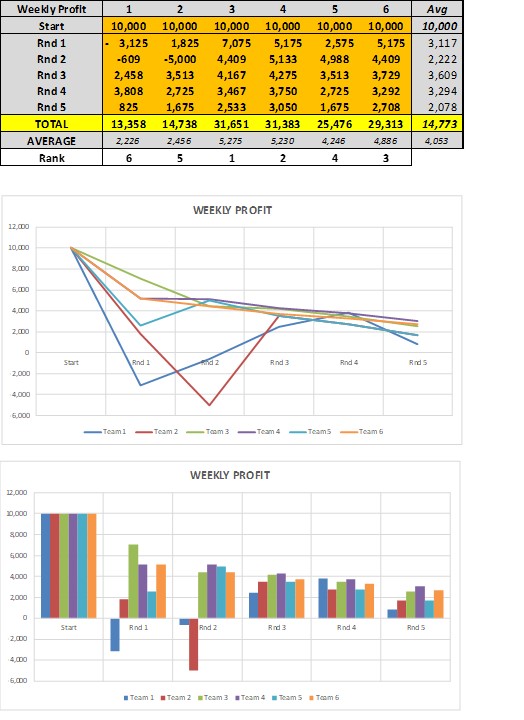Topics
Sim Game, price, place, relationships, competition
Teaching Notes
Introduction
This free marketing Sim Game is a fun activity that incorporates the learning concepts of:
- pricing
- competition
- sales, financials and profitability
- price wars
- game theory
It is a relatively simple game that can be understood very quickly and played within 30 to 45 minutes. It is designed for levels of students from high school students to Master level.
Although students only have a price decision to make, this generally leads to aggressive competition and erosion of profitability for all players/teams involved. This is where the learning outcomes are exposed, particularly for game theory (somewhat like prisoner’s dilemma) – please see below for more information..
As the instructor, you simply enter the price that each team will set, and the game runs on Excel with the results automatically calculated. So there is limited work for you in implementing the results of the game.
Typically, I found this game very engaging because it is a very competitive game where there is generally only one winner. I have structured the pricing mechanism to be very elastic which means that virtually every decision is a win/lose outcome.
And if you don’t normally use SimsGames in your teaching – this is a great game to start with. It’s quick, engaing, and very easy to run as an educator.
- Download the Excel scoring spreadsheet for this free Sim Game here:
- Restaurant Price Game
How this Sim Game Works (you can provide this information to students)
- Each student group runs a restaurant in a tourist area.
- There are a small number of local restaurants – they are identical in their marketing mix.
- They are perceived by the tourists to have similar food/menu, similar location, similar facilities (servicescape).
- The only perceived point of difference is price.
- As the tourists are always new customers, they have NO loyalty – and they will choose between the restaurants based on price.
- The goal for each student group (each restaurant) is to: Maximize profits!!!
Each round – up to five rounds – the student groups will decide a price and secretly tell the instructor, who will enter all prices into the spreadsheet that will automatically calculate sales, market share and profitability.
Instructor tip: After two rounds, I allow representatives from each student group to interact with each other and to reach a negotiated price that they will all agree to. And sometimes I do this as a class discussion – but I then secretly get their “real” price decision.
While most/half of the student groups will adhere to the agreed classroom price, there are always 1– 2 groups who decide to take advantage of the situation and set their own price independently, while they are aware of the decision what most groups will most likely implement.
Obviously, this totally destroys the trust between the groups and then some groups will want revenge. This is executed by engaging in a price cutting war, leading to deterioration of profits often to the point of making losses each round.
How the Sim Game Works (video instructions)
Remember to download your copy of the spreadsheet (please see link above).
Easy to Run in Class and Very Easy Inputs
You only need to input one number per team – which is their price point, as shown…
And the you simply copy/paste the weekly profit results and the results charts and running totals are automatically calculated, as shown below…
A Little Bit About Game Theory
Game theory is more relevant in highly concentrated industries, such as banks, gas/petrol, cinemas, supermarkets, tourist restaurants (as in this Sim Game activity).
When there is a small number of known competitors, they are better understood and more predictable. When we have a less concentrated industry there are too many players and their combined actions are too unpredictable.
Game theory is helpful in developing marketing strategy (such as pricing in this Sim Game), by predicting competitor actions and the impact it may have on our results.
As we know, the goal of marketing is usually to maximize profits, not market shares or unit sales. So, by playing this Sim Game students should recognize that aggressive competitive rivalry is not in any firm’s interests and, in marketing terms, we should look to avoid direct price competition and differentiate!!!
Helpful video to show to students (before playing the Sim Game)
The first is a quick explanation of game theory (the Nash Equilibrium) – which is easy to understand for all age groups and has an example that is very relevant to our Restaurant Pricing Sim Game.
Learning Outcomes
The key learning outcome from this Restaurant Pricing Sim Game is that a price war benefits no team. Even though one team may have “won”, they all ended up making far less money than if they worked together.
Remind your students that their objective was to maximize profits, not to destroy the competition. And that working together is the only way that they can maximize their income.
This means that students have to start thinking a little bit differently about competition – that sometimes we “let sleeping dogs lie” and we do not always be overly competitive.
You can then turn the discussion into how this could be achieved. In the game, normally there is a breaking of trust which is very difficult to rebuild. So you can discuss how that business trust can be re-created and why it is important.
Clearly, the outcome required is to go back to a state of equilibrium where the price is maintained at a point beneficial to all players – such as shown in the game theory video/s.
Extra Instructions (if required)
Video on How to Create a Results Page for the Pricing Game

